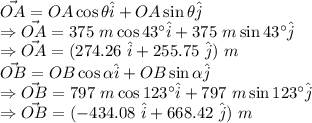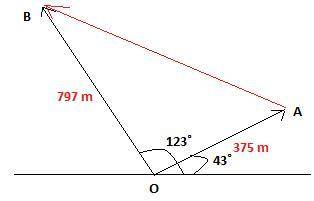
Physics, 17.09.2019 20:30, emmadivaburnsox7ae9
Aradar station detects an airplane approaching directly from the east. at first observation, the range to the plane is 375.0 m at 43.0 ° above the horizon. the plane is tracked for another 123.0 ° in the vertical east-west plane, the range at final contact being 797.0 m. what is the magnitude of the displacement of the plane (in meters) during the period of observation?

Answers: 2
Other questions on the subject: Physics


Physics, 21.06.2019 18:30, Tierriny576
A6,600 kg train car moving at +2.0 m/s bumps into and locks together with one of mass 5,400kg moving at -3.0m/s. what is their final velocity? +0.50 m/s -1.0 m/s +2.5 m/s -0.25 m/s
Answers: 3

Physics, 22.06.2019 00:30, WorkingButNotReally
Comedians like to joke that the reason we haven’t been visited by intelligent life from elsewhere in the universe is that aliens have been monitoring earth’s broadcasts of intellectually embarrassing tv programs, like gilligan’s island, fear factor, the jersey shore, and the jerry springer showand so consider us far too primitive to merit a visit. let’s check the assertion that aliens could have been receiving them. tv programs are broadcast at a frequency of about 100mhz with about 100kw of total power in 30frames per second, which emanatesroughly uniformly in all directions. assume that interstellar space transmits these broadcasts without attenuation. no matter how smart they are, aliens would require at least one photon per frame to interpret our signals. findthe number of photons per unit time per unit area reaching a receiver on a possible planet in the nearest star system, which is about 4 light-years away (a light-year is the distance light travels in a year). if aliens aimed a receiver or detector directly at earth, how big (in diameter) would it have to be to receive a photon per frame
Answers: 2

Physics, 22.06.2019 01:00, winnie45
Red’s momentum vector before the collision is green’s momentum vector after the collision. question 1 options: shorter than longer than equal to question 2 (1 point) saved since green bounces off red, this must be an collision. question 2 options: explosion inelastic elastic question 3 (1 point) saved red transfers of its momentum to green during the collision. question 3 options: little all most none question 4 (4 points) why does red transfer all its momentum to green? back up your answer with information from the simulation. write at least 2 sentences. question 4 options: skip toolbars for . more insert actions. more text actions. more paragraph style actions. question 5 (1 point) now make red much heavier than green. answer the questions below to describe how both red and green behave after the collision. you might want to play the sim multiple times. click on restart or return balls to start over. to see numbers, check the show values box (inside the green box). red during the collision because it transferred some momentum to green. question 5 options: sped up kept the same velocity slowed down question 6 (1 point) green sped up during the collision as it question 6 options: lost momentum to red maintained a constant momentum. gained momentum from red question 7 (1 point) after the collision . . question 7 options: red bounced off green and went to the left. green moved to the right. both green and red stopped as they have lost all momentum. red stopped and green moved to the right. both green and red moved to the right. question 8 (4 points) only some of red’s momentum was transferred to green. why did this occur? back up your answer with information from the simulation. write at least 2 sentences. question 8 options: skip toolbars for . more insert actions. more text actions. more paragraph style actions. question 9 (1 point) now make red much lighter than green. answer the questions below to describe how both red and green behave after the collision. you might want to play the sim multiple times. click on restart or return balls to start over. to see numbers, check the show values box (inside the green box). which is true about the collision? question 9 options: green slowed down after the collision therefore it must have lost momentum. green sped up after the collision therefore it must have lost momentum. green sped up after the collision therefore it must have gained momentum. green slowed down after the collision therefore it must have gained momentum. question 10 (1 point) since green gained momentum, red had to have momentum because you cannot create or destroy momentum. question 10 options: lost kept the same amount of gained question 11 (1 point) since green was so much and harder to move, it caused red to bounce back to the left giving red . question 11 options: lighter. . . . negative heavier . . . . negative lighter. . . . positive heavier . . . . positive question 12 (4 points) now, click on more data at the bottom of the sim. play with different numbers for the masses and starting velocities. you can even make the starting velocities negative! tell me one thing you discovered by adjusting the speeds and masses. write at least 2 sentences. be specific and use words like velocity, momentum, mass, increased, decreased, etc. question 12 options: skip toolbars for . more insert actions. more text actions. more paragraph style actions. part 2: inelastic collisions question 13 (1 point) click on the "less data" box at the bottom of the sim. in the green box, slide the elasticity meter all the way to inelastic so there is 0% elasticity: make the masses whatever size suits you. make sure that green starts out with a velocity of 0 m/s – if you didn’t change this in the last step, you don’t need to do anything. push play and observe! true or false: when red and green collide, they stick together. question 13 options: true false question 14 (1 point) the velocity of red & green after the collision is the velocity that red started off with. question 14 options: larger than smaller than equal to
Answers: 1
Do you know the correct answer?
Aradar station detects an airplane approaching directly from the east. at first observation, the ran...
Questions in other subjects:









Mathematics, 09.07.2021 20:40


 = angle of the initial position vector from the observation point =
= angle of the initial position vector from the observation point = 
 = angle of the final position vector from the observation point =
= angle of the final position vector from the observation point = 
 = displacement vector from initial position to the final position
= displacement vector from initial position to the final position








